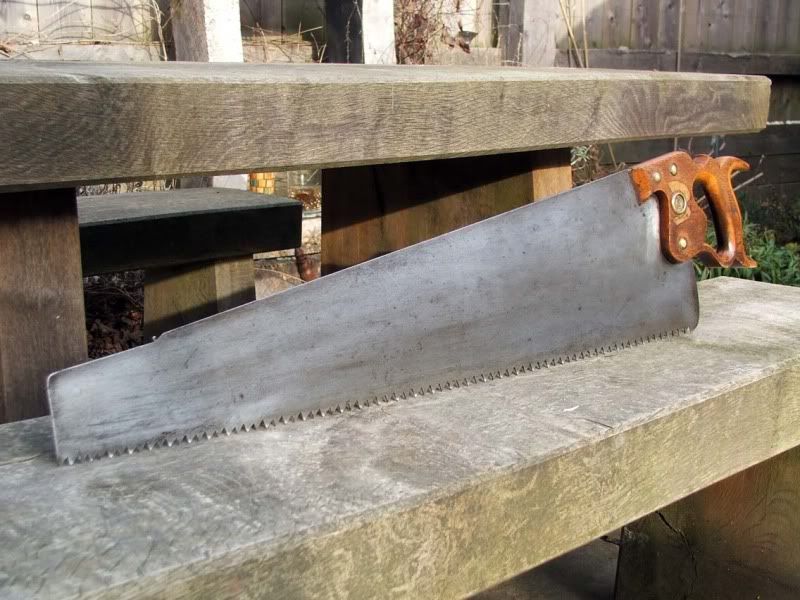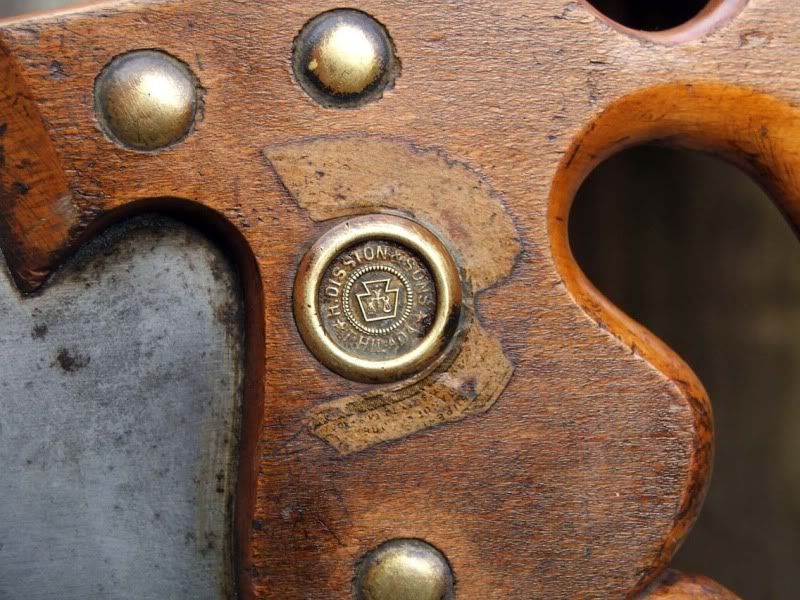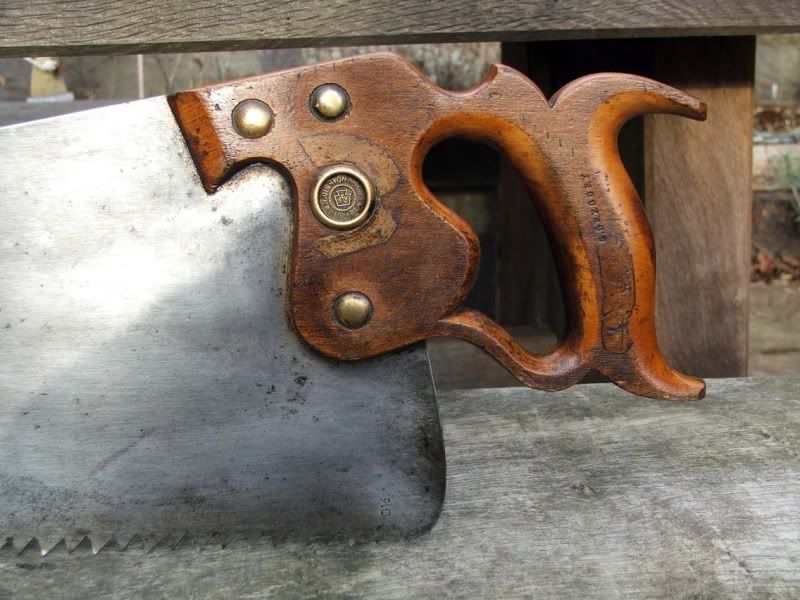I’ve always had and used old hand saws. There is nothing wrong with a modern, plastic handled saw, with its induction hardened universal teeth. In fact for cutting plywood, with its multi directional grain, they’re great, but they’re always short, and the teeth are too small for large green wood, and I’m not that keen on disposable stuff.
I’ve stopped and picked up countless old rusty saws in antique shops, checked the teeth and looked down the line to see how straight they were. Invariably they are past trying to bring back to life as a worker, but I have some excellent saws, some good saws, and some I was being too optimistic about.
A good old saw will outperform any modern handsaw, even when you allow for sharpening time, I’ve tested rip saws against new modern saws, and the cutting time is less than half that of the modern saw.
Sometimes things come together unexpectedly and take you off in a new direction. I found a saw doctor’s book on ebay that looked interesting, I hoped it might have some new (1920s) saw sharpening techniques for hand saws, it didn’t! But it did have a small section on the advantages of using a fly-press for cutting saw teeth in bandsaw blades. Around this time I came across a fly-press with tooling from a saw doctors, set up for re-toothing handsaws. Needless to say it joined my collection of tools in my workshop.
Originally I was going to re-cut some of my old saws. I could re-cut a new saw, but that wouldn’t be as much fun as trying to make a new saw from scratch, and I’d get a saw that would be customised to what I wanted.
Vintage saw design had a lot of facets, hand saws changed over time, with their pinnacle of development at the tail end of the 19th C. Tooth pattern, taper grinding, skew backed, handle position and steel quality all being changed and improved. I have a Disston No7 from this period, and decided to use that as a starting point for my new saw.
After a lot of research on the internet, and asking questions of those in the know I eventually found the steel type and grade required for my handsaw. Spring steel CS95, hardened and tempered to 530-570 VPN, this has a carbon content of around 0.95%. The quality of the steel is vital, it needs to be hard enough to hold its edge, and soft enough so you can file it and the teeth don’t snap off when setting.
So here is how I made the blade.
 The new steel plate (750 x 225 x 1mm).
The new steel plate (750 x 225 x 1mm).
The saw is marked up ready for cutting. The new saw will be longer and deeper the the Disston by about an inch both ways. The saw length is dependent on the stroke length of your arm.
A guide was clamped to the steel plate ready for cutting with a 1mm cutting disk. The cutting was carried out very slowly with multiple cuts, to prevent excessive heat from either buckling or losing the temper of the steel.
When all the cuts are complete the saw is held in a saw vice to have any sharp edges removed.
The back of the handsaw is marked up for taper grinding.
All 19th C hand saws were taper ground; this made the saw thinner along its back edge. This had three benefits.
It made the saw lighter and moved the weight to the tooth line, which improved control of the saw when cutting.
It made the saw less likely to jam in the saw cut.
It reduced the amount of set required,
smaller set = thinner cut = less effort.
Just as in cutting the plate, it is important that as little heat as possible enters the blade; I repeatedly cooled the blade every time it reached touch hot. (Somewhere after warm but still comfortably holdable in your fingers)
I added a nib to the back of the blade. This is completely decorative and not required, but it’s a nice touch that gives a nod to the old sawmakers.
The saw will have a graduated tooth line from 5ppi at the toe, to 3.5 ppi at the heel. (points per inch)
I punched the teeth with a fly-presswith guides to control the tooth size, angle and spacing. The previous tooth stops on the guide to set the spacing for the next cut. The saw is emerging from the blade. You can see the changes is tooth size as I move along the blade.
Each tooth takes about 5- 10 second to line up hold and punch. Cutting the teeth this way ensures no heat enters the steel at the tooth line.
The saw now has a slight curve in the blade from the stamping process, but this is removed later.
The saw blade is now completely shaped. It still needs a final polish, the handle fitted,sharpening and setting.
Another weekends work.
 Here is a nice example of a lovely Disston saw. It's a No7 28" rip with 3 1/2 ppi, in very good condition and showing a nice breast to the saw line. Easy to date to 1896-1917 by the medallion.
Here is a nice example of a lovely Disston saw. It's a No7 28" rip with 3 1/2 ppi, in very good condition and showing a nice breast to the saw line. Easy to date to 1896-1917 by the medallion. This saw still has the remains of the paper sticker around the medallion, which originally would have read:
This saw still has the remains of the paper sticker around the medallion, which originally would have read:












